Banish Boring in the Morning with Breakfast Recipes to Celebrate Organic Week
September 17 to 25, 2016, marks this year’s National Organic Week, the largest annual celebration of organic food, farming and products across the country. With hundreds of events and thousands of retail promotions taking place across Canada, Organic Week showcases the benefits of organic agriculture and its positive impact on the environment, animal welfare, as well as our well-being. Supported by regional partners and coordinated by the Canada Organic Trade Association(COTA), Canadian Organic Growers (COG), and the Canadian Health Food Association (CHFA), Organic Week shines a spotlight on why Canadians should choose to think before they eat.
“With the number of organic products on the market continuously growing, it’s easier than ever to go organic,” says Rochelle Eisen, president of COG. Many of Canada’s top organic farms, wineries, retailers and restaurants take part in Organic Week, offering Canadians the perfect opportunity to experience firsthand the bounty of Canada’s organic harvest. “Whether it’s hosting a potluck picnic for friends or sampling organic wine and beer, we encourage Canadians to help spread the word about how choosing organic means supporting sustainability and promoting animal welfare.”
Some new and exciting trends have been revealed thanks to the Canada Organic Trade Association’s second national consumer survey to be released later this year. The study aimed to understand consumers’ awareness of the benefits of organic agriculture, uncover consumers’ organic purchasing habits and gauge the level of trust Canadians have in organic and non-organic claims.
Key findings from the study show:
The face of organic is changing as more “millennials” are shifting towards organic in Canada; one in five (twenty-one per cent) shoppers from 18 to 34 years say they are buying more organic, while shoppers in older age groups are holding steady.
Eighty-six percent of Canadians expect to increase or maintain their organic spending in the near future.
The number of consumers that are regularly buying organic in the country is around 20 million (fifty-six per cent of Canadians).
“Governments are following in the footsteps of consumer trends,” says Tia Loftsgard, Executive Director of COTA. “Federal investment in the organic sector and provincial initiatives supporting farmers to transition to organic show how consumer-led efforts can truly make a difference. We’re proud to be involved in the continued growth of the organic movement alongside its passionate ambassadors this September.”
More and more Canadians are looking to reduce their exposure to synthetic chemicals and genetically engineered (GMO) ingredients with the aim of taking better care of themselves, their families, and the environment. Coast-to-coast Organic Week events range in scale, from smaller organic farm tours to community-wide organic festivals. Hundreds of health food stores, farmer’s markets and grocery chains will be showcasing organic products and educating consumers.
“With events taking place in communities all over the country, there are so many ways Canadians can support and get involved in the Organic Week celebration,” says CHFA president, Helen Long. “Last year, we saw everything from pickling workshops and farm tours to recipe contests and organic food and drink tastings. These happenings represent the creative ways Canadians are choosing to go organic and how they are making a conscious decision to protect their bodies and the environment, all while supporting local farmers.”
To find out more about Organic Week events or promotions being offered near you, please visit organicweek.ca.
Organic Week was made possible this year by champion sponsors UNFI Canada, Sobeys Inc., Manitoba Harvest Hemp Foods, Nature’s Path Foods, Clif Bar & Company, alive Publishing Group Inc, PC Organics, Mike and Mike’s Organics, Cal-Organics Farms, Yorkshire Valley Farm, Green Organic Vegetables, Field Farm Marketing Ltd., DOM International Limited, Canadian School of Natural Nutrition, Earthbound Farm Organic, Wholesome!, True Organic Juice, DeeBee’s SpecialTea Foods, Mumm’s Sprouting Seeds, Ecocert Canada, Organic Meadow, Pacific Organic Seafood Association, Organic Garage, The Homemade Organics Company, Fromagerie L’Ancêtre, Pro-Cert Organic, Patience Fruit & Co, The Big Carrot, Hippie Foods, Ethical Bean Coffee, Quality Assurance International, and Fairtrade Canada.
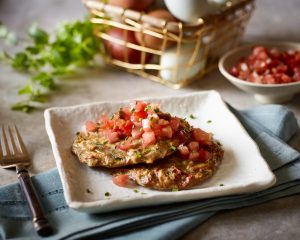
Savoury Egg Pancakes
These easy and satisfying savoury pancakes are quick to reheat in the toaster and are packed with protein, fibre and omega-3 fatty acids. Try it in a wrap or with a salad for a light lunch.
Prep time: 10 minutes
Bake time: 15 minutes
Total time: 25 minutes
Yields: 12 pancakes
2 cups (500 mL) grated zucchini (about 2 small)
1 cup (250 mL) grated sweet potato (about 1 small)
3/4 cup (180 mL) whole wheat flour
6 eggs
1/2 cup (125 mL) ground flax seeds
1/2 cup (125 mL) rehydrated and finely chopped sundried tomatoes*
2 cloves garlic, finely minced
1 tsp. (5 mL) sea salt
1/4 tsp. (1 mL) pepper
Place all ingredients in a large bowl and stir to combine. Dollop 1/4 cup (60 mL) portions of mix onto a large parchment lined baking sheet and spread into 3-inch circles spaced 1-inch apart. Bake at 375F for 15 minutes or until bottoms are light golden brown. Let cool completely and layer with wax paper in between each pancake; freeze in an airtight container for up to 2 weeks. Reheat pancakes in a toaster or microwave. Serve with fresh salsa, hot sauce, hummus or avocado slices.
Tip: You can also cook these savoury delights in a cast iron skillet. Just reduce the cooking time by five minutes and make sure you add a little oil to the skillet before pouring in the pancake mixture.
How to rehydrate sundried tomatoes*: Combine the 1/2 cup (125 mL) sundried tomatoes with 1-1/2 cups (375 mL) water. Soak for one to eight hours.
Nutritional analysis per pancake:
PROTEIN: 6 grams
FAT: 5 grams
CARBOHYDRATE: 12 grams
CALORIES: 112
FIBRE: 3 grams
SODIUM: 270 mg
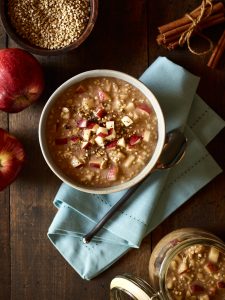
Apple Pie Buckwheat Oats
A hearty, comforting and guilt free breakfast with lots of classic fall apple dessert flavour.
Prep time: 10 minutes
Total time: 8 hrs or overnight
Yields: 4 servings
2 cups (500 mL) coconut milk (in tetra pack)
1 cup (250 mL) diced apple
1 cup (250 mL) applesauce
1 cup (250 mL) uncooked buckwheat groats
1/2 cup (125 mL) rolled oats
2 Tbsp. (30 mL) maple syrup
2 Tbsp. (30 mL) lemon juice
1-1/2 tsp. (7 mL) cinnamon
1 tsp. (5 mL) vanilla extract
Garnish optional: apple chips, apple slices, vanilla yogurt, coconut whipped cream, cinnamon.
Place all ingredients in a large 1 litre mason or canning jar; shake to combine and refrigerate overnight. Serve topped with your choice of garnish.
Nutritional analysis per serving:
PROTEIN: 8 grams
FAT: 4 grams
CARBOHYDRATE: 61 grams
CALORIES: 308
FIBRE: 4 grams
SODIUM: 0 mg
Thanksgiving may be a holiday that we share with our neighbours to the south, but the way we celebrate it is all our own. We don’t give thanks in November (October’s where it’s at!) and it’s not all about football, turkey pardoning and parades with Canadians. We simply like good friends, good family, and good food.
So if you are looking for a new pumpkin pie recipe. I suggest to give this Carnation Classic Pumpkin Pie a try! You can substitute any of the ingredients you want if you want to give it a healthy twist! For more information about Carnation or recipes visit their website: http://www.carnationmilk.ca
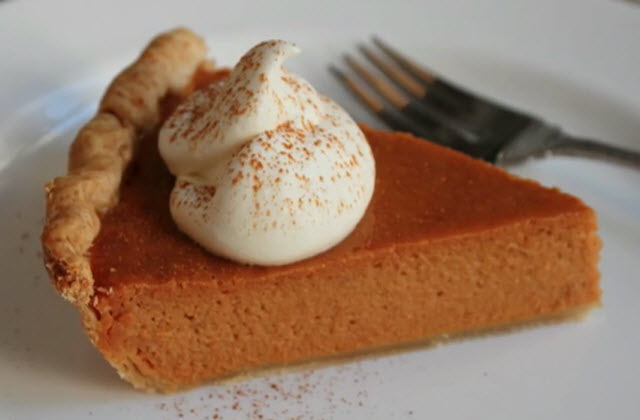
Carnation Classic Pumpkin Pie
Makes: 8 servings
Ingredients:
• 1 can (354 mL) Carnation regular or 2% evaporated milk
• 1 pastry for 10-inch (25 cm) single-crust pie
• 1 3/4 cups (425 mL) pumpkin pureé
• 1 cup (250 mL) packed brown sugar
• 2 eggs
• 2 tbsp (30 mL) Robin Hood original all-purpose flour
• 1 tsp (5 mL) cinnamon
• 1/2 tsp (2mL) ground ginger
• 1/2 tsp (2mL) ground nutmeg
• 1/4 (1 mL) ground cloves
• 1/2 tsp (2 mL) salt
Directions:
1. Preheat oven to 350°F (180°C). On floured surface, roll out pastry to 1/8-inch (3 mm) thickness.
2. Fit pastry into 10-inch (25 cm) pie plate; press into bottom and up sides of plate. Trim overhang and flute edges.
3. Whisk together pumpkin purée, sugar, eggs, flour, spices, and salt in large bowl until smooth and well combined; gradually whisk in evaporated milk. Fill pie shell with evaporated milk mixture. Bake in bottom third of oven for 60 to 70 minutes or until set. Let cool completely on rack.
Tip: Pies can be covered with plastic wrap and refrigerated up to 3 days or frozen up to 1 month.
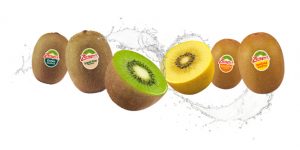
I had the chance to sit down with nutritionist Jessica Tong. The registered dietitian that works with Zespri Kiwifruit. At the time I was very inspired by the Olympics so a lot of my questions have to do with training nutrition. I hope you all can take away a bit of new knowledge about how great Kiwifruit is from the questions that I asked her.
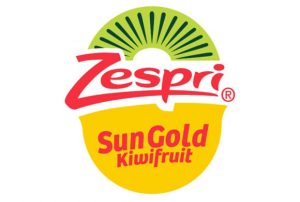
- If I am planning a tough training day when is the best time to have my fruit like a kiwi?
The best time to have kiwifruit is prior to a tough workout. Packed with potassium, vitamin C, vitamin E, antioxidants, and natural sugars, Zespri SunGolds are a nutrient-dense snack of choice to fuel your body, optimize immune function, and ensure proper muscle function during your workout.
- What major nutrients are in a kiwi that will contribute to my health?
Zespri SunGold kiwifruits are excellent sources of vitamin C. They contain 2 times more vitamin C than oranges, which is important for immune function and the growth and repair of bones and tissues. Zespri SunGolds are also a good source of vitamin E, a natural antioxidant. Potassium is crucial for heart function and plays a key role in muscle contraction. One serving of Zespri SunGolds provides as much potassium as a medium banana. Vitamin C, vitamin E, and potassium are all essential micronutrients that are especially important when you are training.
- What is a good go-to recipe for kiwis?
Zespri SunGold kiwifruits can be blended into shakes for a juicy, tropical taste. Or, they can be cut up into smoothie bowls or yogurt. This Sunrise Smoothie Bowl is an excellent recipe rich in fibre, heart-healthy fats, and protein that can be enjoyed for breakfast, snack, or dessert! http://www.zesprikiwi.com/kiwifruit-recipes/breakfast-recipes/sunrise-smoothie-bowl/
- Are kiwis high in sugar? What is the glycemic rating?
Kiwifruits are relatively low in sugar, especially Zespri SunGold Kiwifruits. They are low on the glycemic index (Zespri Green: 39, Zespri SunGold 38) and are appropriate for people with diabetes or impaired blood sugar control.
- How many kiwis are one serving size?
One serving of Zespri SunGold is 162 g or 2 kiwifruits.
- How much more vitamin C does a Kiwi have than an orange?
Based on 100 g, Zespri SunGolds contain 2 times more vitamin C than oranges.
- What is the PH balance of a kiwi and how can it help my athletic performance?
Acid-base balance, or pH balance, affects the body’s metabolic process. It is important that blood pH stays within the range of 7.35 and 7.45, which is on the basic/alkaline side. When blood pH levels become too acidic, an environment is created for bacteria or viruses to enter and to thrive, leading to illness, aches, and lack of energy. This can worsen muscle soreness, create a feeling of fatigue, and compromise athletic performance.
Depending on its ripeness, the pH value of a kiwifruit varies between 3.1 and 3.96, classifying it as a “high-acid” food. However, while kiwis are naturally acidic, they become alkaline after digestion, promoting alkaline balance. Also, kiwifruits are not acid-forming. When acid-forming food is consumed, such as artificial sweeteners, meat, and alcohol, all of which are common in the North American diet, it produces toxins that impact the pH balance of the body and makes the blood more acidic.
- We know that fibre is important and especially with muscle. How much fibre does a kiwi have and how does it help my fitness goals?
1 serving (2 kiwifruits) contain 4 g of fibre. Fibre is slow to digest so it keeps you fuller for longer. This is crucial if you are trying to control calories. Fibre also prevents a blood sugar spike as it causes glucose (sugar) to enter your bloodstream in a slow, controlled manner. This helps to stabilize energy levels and prevent a “sugar crash”. Fibre is also important to promote digestive health and regularity.
- Is there anything else you would like to share? Where can we find more information about you?
Kiwifruit is considered a superfood/superfruit. It is a versatile fruit that is nutritionally superior to apples, oranges, and bananas.
Please feel free to reach Jessica via www.jessicatongrd.com and to learn more about Zespri check out there website HERE.
Larabar Lemon - Add Zest To Your Life
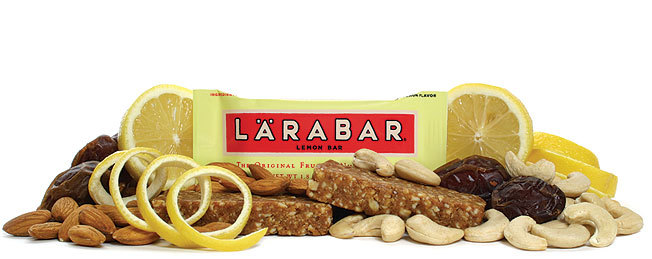
What's Larabar?
Larabar was founded by Lara Merriken in May of 2000. She believed that food should be fun, enjoyable and good for you. She tinkered with recipes an d made her own Larabar bars. She discovered how natural foods enlivened her mind, body and spirit and wanted to share that with the world.
Trends have changed over the years and Larabar has become even more popular because people are actively seeking out foods that are not derived from artificial flavours, sugar or high sodium while they are still looking for great taste. The Lara bars are also gluten free, non-geo, dairy free, vegan and kosher! Each bar contains no more than 9 ingredients and they are minimally processes and as close to their natural state as possible.

I came home last week and to my surprise there was not 1 but 2 packages at my door. I was lucky enough to receive not only the new special edition flavour of Larabar Lemon, but a sample box of flavours including cashew, peanut butter, apple, coconut cream, peanut butter chocolate chip, cocoa coconut chew, chocolate chip, chocolate brownie and blueberry. On top of the samples I also got my very own lemons and tree! This was a little confusing. There also was a bag of dates, cashews and almonds in the box.
Why were all these things included in my package? Why to make my own bars! Thats how little additive ingredients there are in Larabars that I can literally make my own lemon bar with just a food processor, parchment paper, rolling pin and a knife! How cool is that!
There was a little instruction card telling me to place all of the ingredients provided in a food processor and pulse until blended. Once the dough is formed put it into a disc with my hands and roll out between two pieces of parchment paper to my desired thickness. Then cut off excess edges and slice them into bars!
Thank you Larabar for sending me this amazing package. My lemon tree is now soaking up the sun in my living room window and my boyfriend and I are going to enjoy the delicious bars and our homemade zesty lemon bars!
The lemon is available for a limited time only in local grocery stores and online. To find out more about Larabar visit www.larabar.ca
CYREX ARRAY 2 PROVIDES CANADIAN CLINICIANS CUTTING-EDGE TECHNOLOGY FOR ACCURATE
ASSESSMENT AND MONITORING OF INTESTINAL BARRIER FUNCTION
Cyrex Laboratories, a clinical laboratory specializing in functional immunology and autoimmunity, offers Array 2, an intestinal antigenic permeability screen. The Array 2 is the most advanced test on the market to accurately measure intestinal permeability or “leaky gut” as well as assess systemic Lipopolysaccharides (LPS)—a byproduct of bacteria. The Array 2 is unique among clinical testing in its ability to identify the route of damage occurring in the intestinal barrier.
Knowing the pathway of degeneration helps the practitioner narrow his/her focus in identifying the triggers causing damage and choose the most effective gut healing protocol for the patient. Dr. David Perlmutter, a renowned neurologist and leader in preventative medicine who recently released the New York Times Best Seller Brain Maker, said, “I consider the Cyrex Array 2 to be the most effective laboratory study available for evaluating gut permeability.”
Array 2 is recommended for patients who have food sensitivities, abnormal immune cell count and function, or who present multiple symptoms suggestive of autoimmune disorders, such as chronic fatigue, joint pain, skin issues and/or cognitive impairment. Because of the significant correlation between the gut and brain barriers, Array 2 can also be used in combination with Cyrex’s Array 20, a potent tool for assessing permeability of the blood brain barrier.
"With gastrointestinal barrier integrity being a causal mechanism for so many autoimmune and metabolic diseases, there has never been a more important time for those practicing to quantify what is being observed clinically,” says Dr. Randall Gates, D.C, D.A.C.N.B. and Board Certified Chiropractic Neurologist and Dr. Martin Rutherford, D.C., C.F.M.P and Certified Functional Medicine Practitioner. “Simply, the Cyrex Array 2 allows us as practitioners to ascertain and demonstrate to patients the problem at hand.”
Physicians and other licensed healthcare professionals, as well as patients, interested in learning more about Array 2, 20 or any of the Cyrex Arrays that are part of the Cyrex System, are encouraged to visit www.joincyrex.com for additional information.
About Cyrex Laboratories
Cyrex is a clinical immunology laboratory specializing in functional immunology and autoimmunity. Cyrex offers multi-tissue antibody testing for the early detection and monitoring of today’s complex autoimmune conditions. Cyrex develops innovative testing arrays through continuous collaboration with leading experts in medical research and clinical practice. Cyrex technology is built on four pillars of excellence, including the antigen purification system, optimized antigen concentration, antigen-specific validation and parallel testing technology. Cyrex is a CLIA licensed laboratory based in Phoenix, Arizona and holds a Medical Device Establishment License in Canada.
USING MILK TO REFUEL, REHYDRATE AND REPAIR A GREAT OPTION AFTER WORKING OUT
Sports dietician offers advice on why milk has so many benefits for athletes
Milk and chocolate milk have been getting increased attention as go-to recovery beverages of choice for those who workout, but are they really as great as so many people believe? St. Vincent Sports Performance sports dietician Sigornie Pfefferle says absolutely.
So what makes milk so great? It's all about refueling, rehydrating and repairing:
Refuel
"During a workout, our muscles primarily use carbohydrates, which are stored in our bodies as glycogen, as a fuel source," Pfefferle says. "Well, just like gas for a car, as you work, those fuel stores get burned leaving you on empty at the end of a workout. In order to recover quickly, you have to refuel/refill the tank with carbs, and milk, especially chocolate milk is a great source of carbs."
Rehydrate
"It is essential to replace the fluids and electrolytes, primarily sodium, lost via sweat post-exercise," Pfefferle says. "Milk not only helps replace the fluid lost, but, because it contains about 150mg/cup of sodium, it can help replace some of the electrolytes lost in your sweat, too."
Repair
"Intense, long workouts break down muscle; in order to repair muscle, you need protein," Pfefferle says. "Milk is an excellent source of high quality protein needed to repair and rebuild muscle. In fact, research has shown that consuming protein and carbs, both of which are contained in milk, immediately post workout leads to a six times greater rate of protein synthesis vs. waiting 3 hours to refuel."
Pfefferle says milk not only covers the three R's of recovery, but it's also packed with other vitamins and minerals essential to everyday health, most notable are calcium and vitamin D, both essential to bone health.
"So next time you are looking for a post workout recovery option, go for a tall glass of milk," Pfefferle says.
About St. Vincent Sports Performance
St. Vincent Sports Performance has supported and helped develop world-class athletes since 1987. The first and largest hospital-based program of its kind in the United States, St. Vincent Sports Performance employs over 60 Certified Athletic Trainers, sports medicine physicians, certified strength and conditioning specialists, licensed sports psychologists and registered sports dietitians. Together they have trained athletes at every level from middle school, to Olympians, to the NFL and NBA, to Motorsports and NCAA athletes. Learn more at
definingsportsperformance.com.
Inflammation: Why Food Matters
Did you know that inflammation is a component of the vast majority of diseases? It originates in the gut with an autoimmune reaction that advances into systemic inflammation. Examples of chronic inflammation diseases include cancer, arthritis, heart disease, chronic peptic ulcer, and Crohn’s.
Unfortunately, doctors have a tendency to prescribe medication instead of figuring out the original source of the problem. Why is this an issue? Because taking medications only blocks the inflammation, it doesn’t quell the disease process. Inflammation is the body’s way of defending itself, and for acute diseases it is beneficial, but for chronic diseases it exacerbates the problem.
Dr. Lanae Mullane, the Director of Nutrition at LifeSpan medicine is a huge proponent of helping treat inflammation by changing one’s diet. That’s correct, food matters. Everyone reacts to food differently, so why do doctors give blanketed statements about what to eat? To put it bluntly, they shouldn’t.
When clients come to see Dr. Mullane, blood is drawn to see which foods cause that specific person inflammation. Foods are then put into three categories: green, yellow, and red.
Green foods are what the client should focus on eating, yellow are neutral, and red are foods that should be avoided. Dr. Mullane always suggests strictly eating what’s on the green card for 4 weeks, and then slowly (one by one) incorporating foods on their yellow card to see if it causes inflammation.
For more information on inflammation and why food matters please visit www.lifespanmedicine.com. If you would like to speak with expert nutritionist Dr. Mullane and for all press inquiries contact Brooke Cockrell at brooke@kipmorrison.com or 818.209.3800.
ABOUT LIFESPAN MEDICINE
LifeSpan medicine is an integrative, functional medical practice with a team of doctors that offer the most advanced technology for non-invasive medicine. The practice has two locations in Santa Monica and Dallas. Clients range from the average person looking to be healthier to NFL, NBA, and Olympic athletes to movie stars and Fortune 500 executives.
ABOUT DR. LANAE MULLANE
Dr. Lanae Mullane conducts individual consultations and assessments to identify deficiencies and imbalances and customizes plans involving lifestyle modifications, diet, supplementation and exercise. Her clients include families, executives, athletes and young professionals looking to perform and be their best. She helps each client reach any nutrition or health goal they may have from weight loss, to more energy, less inflammation or just feeling and looking better overall. She utilizes her expertise in the kitchen to provide specialized menus and recipes to fit each clients’ individual preferences, food sensitivities, biochemistry, and overall lifestyle.
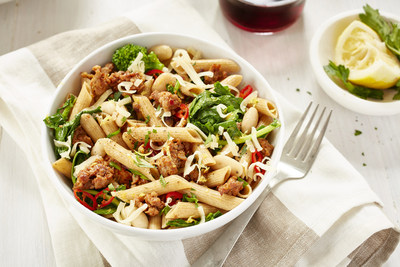
Canadians embrace food – we value family traditions, recipes passed down through generations, global trends and show a lot of heart for our local producers. For almost 150 years, Catelli pasta has grown up with Canadian families through a shared passion for food – not to mention a shared birthday, a proud heritage and strong ideals. And like our country, Canadian families have evolved. Blended, single-parent and multi-ethnic families are part of our modern mosaic and match our evolving tastes and preferences – from locally sourced yet globally influenced, to simple, healthy and trusted ingredients. But what has stayed the same is our love of pasta. That's why leading up to this special anniversary year, Catelli along with three celebrated Canadian chefs – Cory Vitiello, Martin Juneau and Michael Allemeier – are taking a journey with Canadians to explore this universal food and its relationship with families across Canada today.
And there's no doubt we love our pasta. Case in point, almost 9 in 10 households have it in their cupboard. What's more, it's a 'real' food in an industry striving to meet the demands of today's health-minded Canadian families. So what do Canadians love about it?
Quite simply, pasta makes us feel good. In fact, three-quarters of Canadians said they feel relaxed cooking pasta because it's easy meal making or like that it offers so many options, most strongly felt by Ontarians at 82 per cent.* Other feelings cooking pasta evokes? Nearly a third of Canadians say experimenting with new pasta recipes makes them feel excited and half of Canadian parents in particular, feel confident they can create a good meal when cooking pasta.*
"It's not surprising that cooking pasta makes us feel good, and we get excited to experiment with it," says Montreal chef and Dad to two, Martin Juneau. "Families today really value the 3 E's of a pasta meal – easy, efficient and enjoyable. It's why I'm excited to start talking with Canadians about its place in their homes. Food has never been a more talked about subject and pasta offers us a range of meal options and nutritional benefits – not to mention that its simplicity gives us back the gift of quality family time, one of the biggest challenges we struggle with today."
In fact, when it comes to the role pasta plays in Canadians' lives, the majority say it means less kitchen time because of its easy prep or that it provides a lot of options for their family.* Health is important too. Almost half say pasta is a healthy meal option due to its simple ingredients and the fact that it can be further paired with 'good for me' ingredients.* And with healthier pasta options such as Catelli Smart®, with its very high source of fibre, Catelli® Gluten Free and 100% whole grain Catelli® Healthy Harvest®, serving this quality, delicious meal to the family is adding to the good feeling too. Six in 10 parents with kids in the household shared that pasta makes their kids happy or their family feel fueled.*
"There isn't a typical Canadian family anymore – and few of us would say our lifestyles are typical," says Doyle Brown, Senior Brand Manager, Catelli. "Just like Canadian families, pasta has become such a versatile food with so many ways to experience it – we're moving away from the traditional view of it as just an Italian meal. Canadians also have a lot to do with the many ways we enjoy pasta today – whether it's a fresh spin on an old favorite or something completely new and inventive."
Look no further than our quest for recipes. In 2015, Spaghetti Bolognese was the 7th most searched recipe by Canadians according to Google Trends, with lasagna in close pursuit in 9th. And breakout recipe searches have recently included everything from 'one pot pasta' and 'pasta bake' to 'pesto pasta' and 'basil pasta'.** Additionally, our love of local means we're cooking more with real, simple ingredients grown or raised close to home and available in local grocers or farmer's markets.
"The popularity in using fewer and fresher, local ingredients is helping build pasta's quality reputation," says Toronto Chef Cory Vitiello. "Canadians are learning they don't have to be trained chefs to get creative with their pasta dishes, and I'm looking forward to seeing what they've been up to in their kitchens!"
Yet, Canadians don't shy away from practicality either. The top two reasons Canadians add pasta to their shopping lists include: how easy it is to make a pasta meal (59%) and how affordable pasta is (48%).* Whether a bustling family household or a single individual, pasta remains one of the most reasonable meals on the market. And, the taste factor is never far behind – 4 out of 10 say they just can't live without it!*
"Pasta has a special place in Canadian households – and what makes it special is different for every family," says Chef Michael Allemeier. "It's a comfort food, an easy meal time win, a quick dinner fix and a crowd-pleasing entertaining option – and the recipe options are really endless. Look how butternut squash provides a delicious twist to meat lasagna or how fresh goat cheese and pesto puts a new spin on spaghetti."
The Catelli Pasta Journey
The Catelli team is hitting the road in 2016 to learn more about how today's Canadian families are enjoying pasta and inviting them to share their stories, their recipes and even their pictures at #CatelliFamilies. This spring, a video series documenting some of these stories will be introduced and a new collection of recipes inspired by our modern taste preferences – and featuring favourites from chefs Cory Vitiello, Martin Juneau and Michael Allemeier, will be available at www.catelli.ca. The majority of Catelli pastas – including 100% whole grain Catelli® Healthy Harvest® and fibre rich Catelli Smart® – are not produced with ingredients that have been genetically modified.
About Catelli Foods Corporation
Catelli is a Canadian pasta company founded in Montréal, QC in 1867. It holds the ranking of #1 Canadian pasta brand and is the leader in the health and wellness pasta segment. With more than 75 products available in its line-up today, including Catelli Smart®, Catelli® GlutenFree and Catelli® Healthy Harvest®, Catelli offers pasta made from simple, wholesome ingredients for every kind of family taste and preference.
About the Research Study:
A study of 300 Canadians was completed online between December 3 – December 8, 2015 by Environics Research.
|
*Environics Research Study (in partnership with Catelli), 2015
|
|
**Google Trends, 2015
|
10 Fueling Tips For Marathoners
by Tara Martine, MS, RD, LDN
Wise marathon preparation is a holistic endeavor. Sleep, recovery, cross-training, and most of all, nutrition, all play essential roles. Ask any experienced runner: the right foods, eaten in the right quantities and at the right times, can make all the difference when race day arrives. Here are ten nutrition tips any runner would be smart to follow:
1. Winners plan ahead.
Many marathoners wait until a week or two before the big event before thinking about their diet. But race nutrition is much more than five days of carb loading. Start thinking about what you’ll eat at least a couple months before the race. As you’ll see below, there’s a lot to do.
2. Stomachs need training too.
About eight weeks before your race, figure out which brands and types of sports nutrition products settle best in your stomach. The only way to determine this is to experiment. Simulate your race-day nutrition plan during your long workouts. Aim for 30-60 grams of carbohydrates, 24-48 oz. of water, and 400-800 mg sodium per hour.
3. Plan your final meal.
Within a month of the race you should have your race-day meal plan dialed in as well. General guidelines are 1-2 grams of carbohydrates per kilogram of body weight 1-2 hours before the race, OR 3-4 grams of carbohydrates per kilogram of body weight 3-4 hours before. Practice eating a variety of breakfast foods before your long runs to see how they digest. Avoid high fat foods because fat takes a long time to digest. Good options are bananas, toast, oatmeal, bagels, fruit, cereal, potatoes or rice.
4. Be good to your body during race week.
During taper week, the goal is to rest your body and full recover from all the hard work you’ve put in. Replenish with fruits, vegetables, whole grains, beans, legumes, nuts and seeds. Avoid processed foods. Shoot for 70% of your total calories from high carbohydrate foods.
5. Don’t worry about your weight.
Don’t be alarmed if you gain weight during taper week. For every gram of stored glycogen, the body stores three grams of water, which is used to help convert the stored carbs into energy once you begin racing. So drink plenty of water and relax.
6. Load up on nitrates.
Everyone knows about carbs, but few realize how important nitrates are to performance. Nitrates, found in plant foods like beets, argula and swiss chard, are converted into nitric oxide, a potent vasodilator that increases blood flow to the heart and working muscles. A good idea is to drink eight daily ounces of a performance juice like Beet Performer for seven days prior to your race, and another eight ounces the morning of the race.
7. Eat your pre-race dinner early.
Eat an early high-carbohydrate, low-fat meal to ensure that your body has enough time to fully digest and eliminate everything. Avoid foods that can trigger heartburn including spicy foods, high-fat foods deep-fried foods, highly acidic foods like tomatoes, chocolate or mint. Foods that are lower in fiber, like regular spaghetti, may help prevent diarrhea, intestinal cramping and bloating.
8. Don’t try anything new on race day.
The biggest rule of thumb for race-day nutrition is don’t try anything new. Eat the breakfast that you have perfected over the last month at the time that works best for you.
9. Fluids matter.
If you normally consume coffee in the mornings, then do so on race day. Hot tea or coffee often helps clear out your bowels before the gun goes off. Hydrate yourself with 1.5-2.5 cups of fluid 2-3 hours before the race. This will ensure you are fully hydrated and allow enough time to void excess fluid before the race starts.
10. Add carbs a half-hour before the gun.
To top off your energy stores, you might want to consume 15-30 grams of carbs within 30 minutes of the event start in the form of a gel, chews, or sports drink.
Following a thoughtful nutrition program will give you confidence once your race starts. So plan early, follow the plan, then get out there and enjoy your day. You’ve worked hard for it!
# # # #
TARA MARTINE, overall women’s winner of the 2014 Savannah (GA) Rock ‘N Roll Marathon, is a registered dietitian, licensed dietitian/nutritionist, and founder/owner of Whole Impact Nutrition. She specializes in wellness, sports, and plant-based nutrition.
Food ads significantly influence eating behavior, says Yale study
|
| New Haven, Conn.—How greatly does food advertising influence eating behavior? Quite a bit, a new Yale University meta-analysis of 45 studies suggests. The results, the authors say, should rekindle efforts to restrict food industry advertising, especially to children.
“Up to 26% of variance in eating behavior or eventual weight outcome has to do with craving and other responses to food cues, especially visual food cues,” said Hedy Kober, professor of psychiatry and psychology and co-author of the paper published online in the journal Obesity Reviews. “The evidence is incontrovertible. And if food ads are that powerful, do we really want these ads running on Sunday morning cartoon shows?”
There has been a long debate about the magnitude of the effect of advertising on eating behavior, Kober said. Some studies have suggested the effect was minor, while others showed food cues have a major impact on eating and eventual weight gain.
To assess the magnitude of the effect across all studies in the field, Kober and graduate student Rebecca G. Boswell analyzed 69 statistics representing 3,292 participants from those studies. They report a significant effect of exposure to food cues and food craving on both eating behavior and weight gain, even with the inclusion of studies that had shown little or no impact of the food cues. Exposure to food cues such as food ads increased eating and weight gain in children and adults, nondieters and dieters, and lean and overweight individuals |








